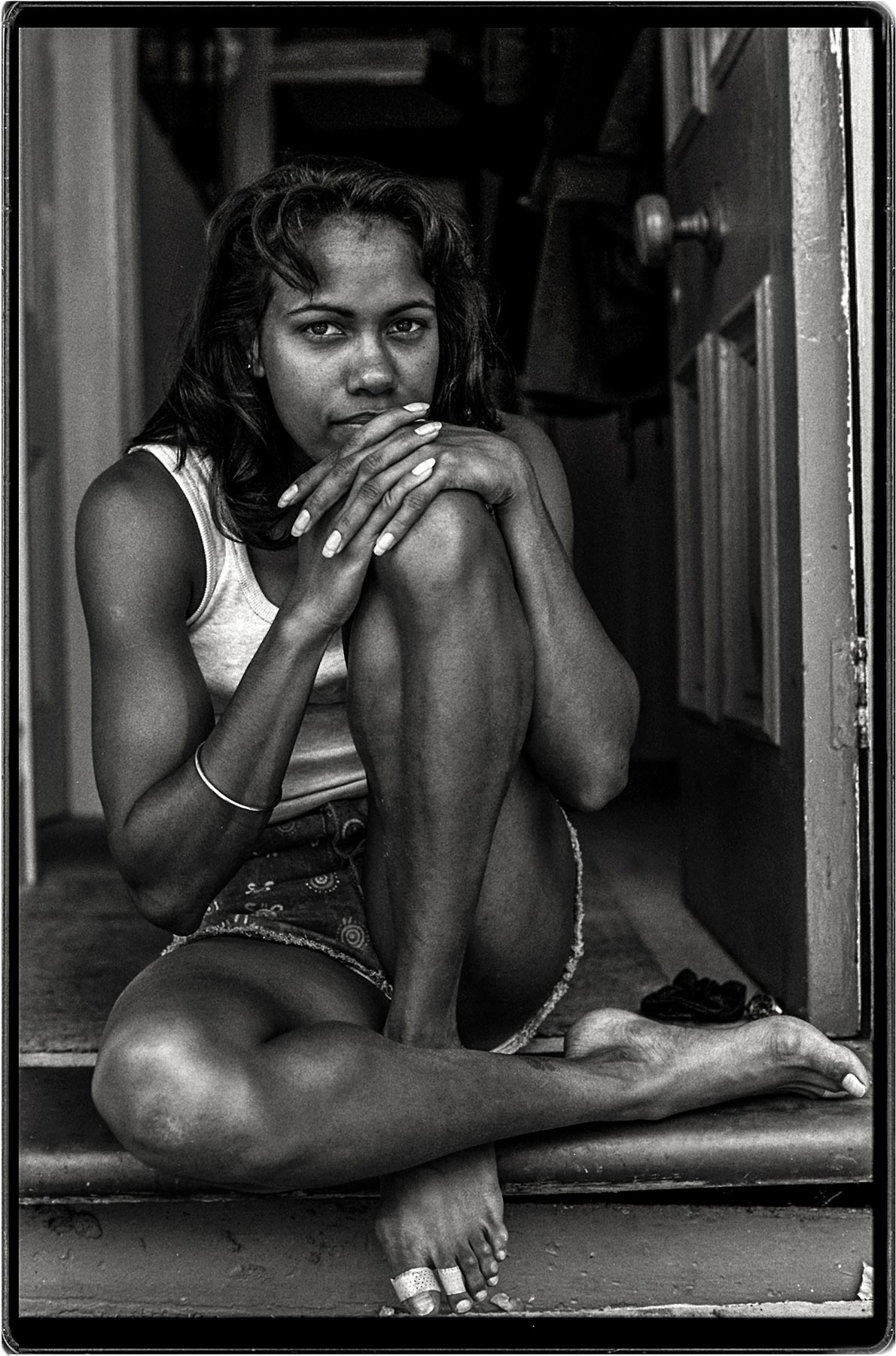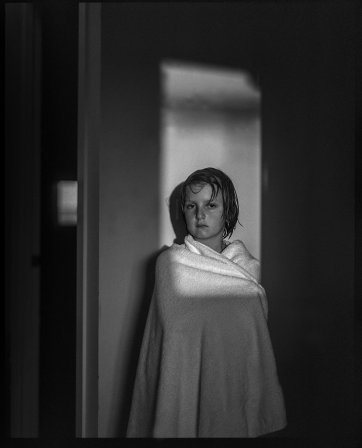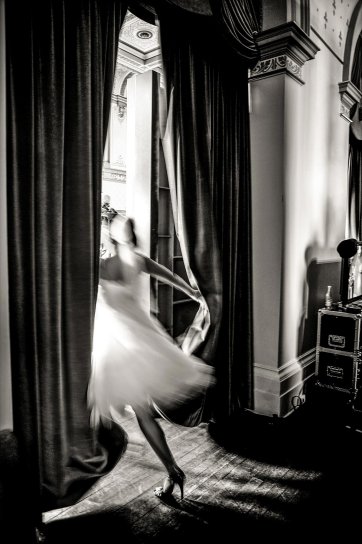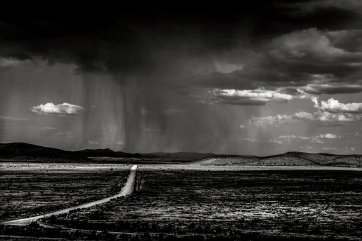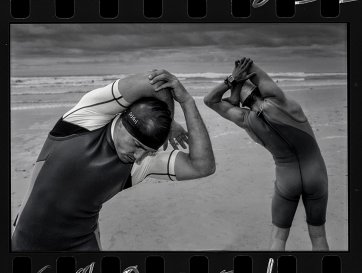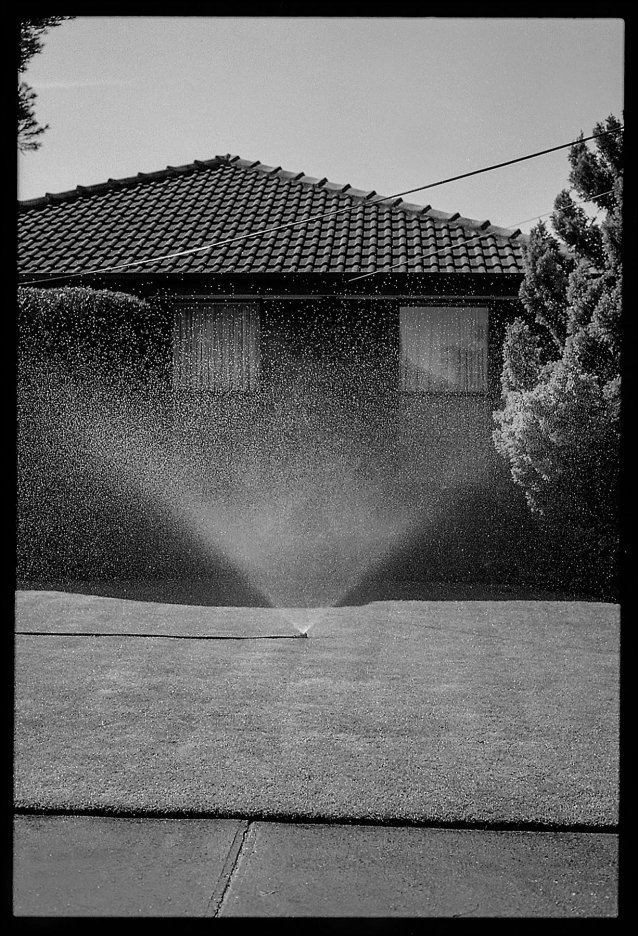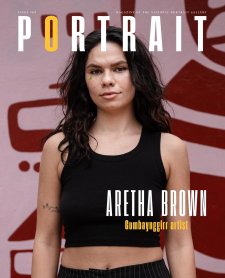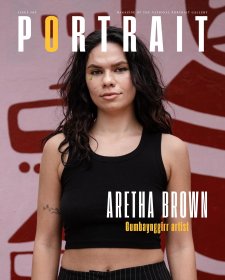Cathy Freeman, 1998 Julian Kingma. © Julian Kingma
I first met Julian Kingma in late 2013. Two colleagues and I had driven from Melbourne’s centre to the coast on a sunny day to interview him at home.
We were working on the National Portrait Gallery’s 2014 exhibition PROMO: Portraits from Primetime. While Julian was clearly more comfortable listening than talking, his intense enthusiasm for his craft, the joy he finds in making images, and his boundless interest in people and the world quickly melted his nervous hesitation at being on the other side of the camera for once.
Almost a decade later, in late 2022, Julian visited me at the Gallery and we spent a day looking over hundreds of small prints of his work that he had selected from his archive. Observing an artist confront the creative arc of a career is a profound experience for a curator. For the photographer, every image carries a remembered environment, memories of the time surrounding that moment, the emotions lived, and the people encountered. Julian told me he had sifted through ‘thousands and thousands of negatives … I found all this work that I’d never looked at. I saw the passing of time within my family and the people I know’. This experience is particularly intense for a photographer whose empathy enlivens everything he shoots: ‘I’ve been crying over the light box the last couple of years,’ he added with a smile.
1 Lola - Last Summer Days, 2021. 2 Hamish, 2010. © Julian Kingma. Both Julian Kingma.
Our conversation flowed over sequences and parallels in the prints spread across a meeting room table embedding Julian’s portraits, with which I was very familiar, in their emotional and visual context, which was unfamiliar and intriguing. Now a four-time National Photographic Portrait Prize finalist – Lola – Last Summer Days was selected for the 2023 Prize – Julian has 11 works in the Portrait Gallery collection. Since answering a tiny ad in the newspaper which read ‘Cadetship, darkroom assistant at The Herald newspaper’, and working for a decade as features photographer at the Sunday Age, Julian’s portraits have appeared regularly on Good Weekend covers and his work appears in most major national magazines across the fashion, music, food and travel genres. He also works with The Australian Ballet and the Sydney Symphony Orchestra. Julian’s archive spanning more than 30 years includes personal family portraiture, landscapes, documentary and observational photography. His distinctive way of seeing the world beyond the face reveals the sources and origins of his portraiture’s impact.
1 Backstage – fashion week, 2005. 2 Flinders Ranges, South Australia
, 2012. Both Julian Kingma.
© Julian Kingma
Julian’s instinct for line, form and proportion reaches deep into his early training in drawing before being beguiled by the camera. ‘When I was six or seven, I wanted to be a book illustrator. I was a shy, anxious kid. I would draw every day after school and weekends,’ he recalled as the table further disappeared under layers of prints. Later, he did a lot of life-drawing classes. Photography was only his elective at RMIT, but ‘it grabbed me the moment I saw a print come up in the developing tray. It felt like drawing without the laboriousness of physically rendering it’. In one personal portrait his son, wrapped in a towel with wet hair and an intense unreadable gaze, is framed by a rectangle of light that makes the image feel like a contemporary photographic commentary on the Old Masters. The contour of a towel left carelessly by a pool mirrors the curve of the swimmer’s body in the water forming Hockney-like patterns with hints of Dupain. On his local beach, two surf lifesavers doing their stretches arch inwards simultaneously like dancers or pillars. Across Julian’s archive, his personal creative history manifests in images where light, shape and space form compositions that seem impossibly serendipitous.
Back in 2013, sitting in his study surrounded by photographer’s books, Julian’s advice to emerging photographers was: ‘Know your history!’ He told us one of his biggest influences was American photographer Arnold Newman, whom he photographed for Harper’s Bazaar, and who famously observed ‘photography is one per cent talent and 99% moving furniture’. To extend Newman’s quote as a metaphor, the furniture Julian moves out of the way for himself and his subjects includes ego, vanity, self-consciousness, pretence, bravado, assumptions, expectations and judgement. That leaves both photographer and subject alone with their vulnerability and humanity – which shines through the images. Julian conveys the same familiar warmth in both his portraits of his sons as they are growing up and those of his famous subjects.
1 Shaun Micallef, 2017. 2 Harold Holt swimming pool, 1998. Both Julian Kingma.
© Julian Kingma
‘I am instinctive in the way I view the world,’ Julian reflected. ‘I love the ambiguity. I want people to feel something that I felt in a moment of uncertainty.’ As a fashion model disappears through a curtain, there is a strange urgency – the question of whether she is escaping something inside or late for something outside is held there, unresolvable. In a close portrait, comedian Shaun Micallef covers his face with his hand in a gesture that is dramatic, awkward and natural all at once – the question of whether he is smiling or exasperated is held there, unresolvable. In one deceptively straightforward image of a house with a sprinkler, a complex world is conjured. There is a tension present in this unwelcoming and strangely comic scene: as the son of immigrants – ‘a little Dutch boy’ – the suburbs were places where Julian failed to grasp Australian mainstream culture, embodying the feeling of not-fitting-in. ‘Tension is my favourite word – the moment where something is about to go pop.’
When taking portraits, Julian maintains the spontaneity of his observational, personal and landscape imagery by going into shoots with only a vague idea of a concept, thus forcing himself to respond to the person and the situation. He is not a big-set big-crew portrait photographer. Endlessly curious about people, he spends the vast majority of the time just talking with his subject – often to their surprise. This ability to read people and their mannerisms, compose the shapes in space, and know what will work in a portrait is another legacy of his life-drawing training. In his portrait of Cathy Freeman, she is comfortably curled in a doorway, her long fingers resting over her knee slightly obscuring her face, her bandaged toes in the foreground the only reference to her athletic fame. Julian’s own sense of vulnerability leaves his images open to what he finds in the moment, allowing the precariousness of the human condition to find form and offering a sense of closeness to his subjects.
1 Tom at the drain, 2020. Courtesy of the artist. © Julian Kingma. 2 Jan Juc Surf Life Saving Club, 2015. © Julian Kingma. Both Julian Kingma.
A crucial visual and emotional motif that accumulates metaphoric force across Julian’s archive is water. Through his lens, our human experience of the passing of time finds form in water shaping landscapes, collecting on windows, rolling in waves, shining in pools, or tumbling from the sky. The images understand time’s rhythms – fast, slow, frozen, forever paused – often simultaneously. During the COVID-19 lockdowns Julian came to realise how important water was for his mind and practice: ‘a horizon with water has a calming and resetting effect and that has really come into my work … I love to surf, to feel the water.’ Near home, over four years, he had registered the shapes, horizon and light at certain times of the year that became the setting for his highly commended 2021 entry to the National Photographic Portrait Prize, Tom at the Drain. Julian used a 5x4 camera and loved that it took ‘only four dark slides’. ‘It’s close to my heart too … it’s a picture that I’m going to be happy to have on my wall or in my archives till I fall off the twig.’
After our day together combing through prints from Julian’s archive and reflecting back on our first meeting a decade earlier, a deeper and more nuanced understanding of his portraiture emerged for me. His quietness amplifies evocative details, gently forming powerful stories. Single images oscillate between the charming and beguiling, unsettling and mysterious, comforting and melancholy. ‘When I look back on the early days on the newspaper and being sent out to do to portraiture,’ he told me over the phone later, ‘I always wanted to do something interesting and disarming. I wanted people not to flick past it.’ He also has a darkroom-born drive ‘to make every picture count’. Julian sees the shape, balance and tension in the world and quietly draws your attention to it, whether it be a river, a window, a street, or a face.
For more information visit juliankingma.com
